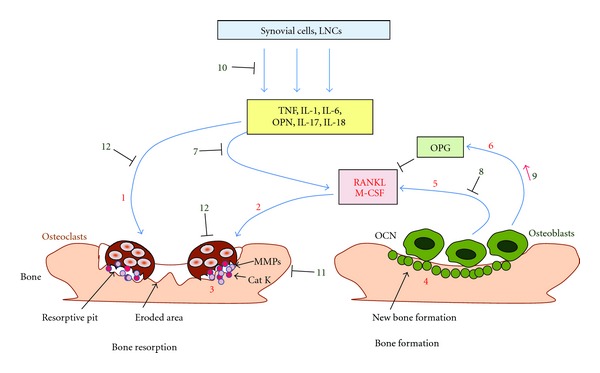Figure 1.

Bone remodeling involves the balance between osteoclast and osteoblast activity, and this balance can be influenced by herbal products. Osteoclasts activated by proinflammatory cytokines (no. 1) and RANKL/M-CSF (no. 2) initiate bone resorption by releasing catalytic enzymes like Cat K and MMPs (no. 3) in a resorptive pit formed on the bone surface. Osteoblasts facilitate bone formation by laying down a matrix, which subsequently is mineralized (no. 4). Osteoblasts produce RANKL (no. 5), which initiates osteoclastogenesis, while OPG (no. 6) inhibits RANKL. Natural products can afford protection against bone damage by (a) inhibiting RANKL production by activated T cells (no. 7) and osteoblasts (no. 8), (b) increasing the production of OPG (no. 9), which in turn keeps RANKL in check, (c) suppressing the proinflammatory cytokines (no. 10), (d) inhibiting production of Cat K and MMPs (no. 11) as well as their activity, and (e) inhibiting osteoclast formation (no. 12). The above-mentioned numbers 1–12 in parenthesis correspond to the numbers in the figure (⊣: inhibition) (Cat K, Cathepsin K; GM-CSF, granulocyte-macrophage colony-stimulating factor; IL, interleukin; LNCs, lymph node cells; M-CSF, macrophage colony-stimulating factor; MMPs, matrix metalloproteases; OCN, osteocalcin; OPN, osteopontin; OPG, osteoprotegerin; RANKL, receptor activator of NF-κB ligand; TNF, tumor necrosis factor-α).
